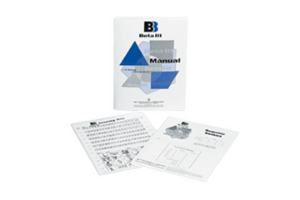C. E. Kellogg, N. W. Morton
Overview:A nonverbal measure of cognitive abilities in adults
Age Range:16:0–89:11
Administration:Paper-and-pencil
Completion Time:30 minutes
Scores/Interpretation:Scaled Scores, General IQ Score, Percentile Ranks
Publication Date:1999
Obtain a quick assessment of adults’ nonverbal intellectual abilities with the Beta III. Beta III is easy to administer and score and is useful for screening large numbers of people for whom administering comprehensive test batteries would be time-consuming and costly. It is especially useful when assessing low-functioning or low-skilled individuals. Beta III can be administered by group or individually.
Beta III is the latest revision of an instrument with a long and distinguished history. The original version was developed by the U.S. Army during World War I to assess the intellectual ability of illiterate recruits. In 1934, Kellogg and Morton revised it to make it suitable for civilian use. Beta III is an updated version of the Revised Beta Examination, Second Edition,published in 1974.
Various Applications
The test has a variety of occupational and educational applications. Appropriate uses include prison systems assessing the intellectual ability of inmates, companies evaluating the employment readiness of potential new hires, and vocational schools determining placement of students. Beta III is also appropriate for use with ESL individuals, as no reading is required. Administration instructions are available in English and Spanish.
Easy to Use
Professionals familiar with Beta II can administer Beta III with minimal training. Technicians, paraprofessionals, and others in the fields of psychology and education can also administer Beta III with training and supervision. It is easily hand scored with a key.
Reliable and Valid
Extensive reliability and validity studies were conducted with Beta III. The norm sample included 1,260 adults. Validation data were collected using individuals with Mental Retardation and more than 400 prison inmates. The standardization sample was stratified by age, gender, race/ethnicity, educational level, and geographic region according to 1997 census data.
Beta III was validated using other well-known tests, including the WAIS®–III, ABLE–II, Raven’s Standard Progressive Matrices, Revised Minnesota Paper Form Board Test (RMPFBT™), Personnel Tests for Industry-Oral Direction Test (PTI–ODT™), Bennett Mechanical Comprehension Test®(BMCT®), and Revised Beta Examination, Second Edition (Beta II).
Features & Benefits
Beta III features:
- New norms
- Updated and larger artwork
- New items
- New subtest (Matrix Reasoning)
- Extended (upward) age range
- Low floors for individuals with average and lower cognitive abilities
- Higher ceiling with more challenging items
Areas of Assessment
The five subtests are:
- Coding
- Picture Completion
- Clerical Checking
- Picture Absurdities
- Matrix Reasoning
Materials
Beta-III Brochure (PDF- 214 KB)





